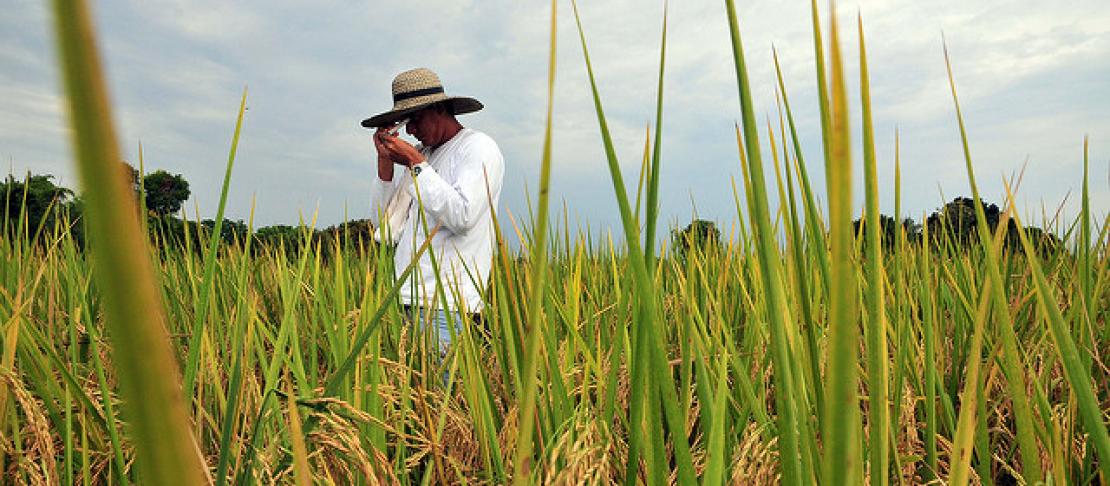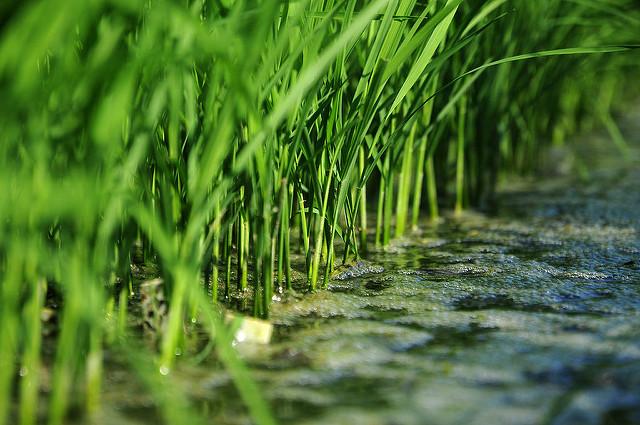Low carbon rice in Latin America: What does it take to make this happen?

Study explores how to cut emissions from one of the region’s most popular crops while still keeping plates full.
There’s rarely a lunch without rice in Latin America. Consumption per capita in the region has more than tripled from 1924-1928 to 2008-2010 (from 9 kg/person to about 30 kg/person). But even though productivity and the area of rice cultivated have both increased, Latin America is still short on the grain by over 1 million tonnes, leaving the continent depending on imports. While there is still plenty of land to grow more rice, the emissions of associated greenhouse gases (GHGs) will have to decrease.
A new study from the International Center for Tropical Agriculture (CIAT) and the CGIAR Research Program on Climate Change, Agriculture and Food Security (CCAFS) explores how much we know about GHG mitigation strategies for rice systems in Latin America and methods for more sustainable production. The researchers look at how rice management and technical options in the region can help mitigate GHGs, mainly methane (CH4) and nitrous oxide (N2O), taking into account countries’ local conditions.
Globally, methane from rice fields is responsible for about 10% of non-CO2 emissions from agriculture. Soils used in agriculture also produce 60% of anthropogenic N2O emissions. Available research says that methane emissions vary widely across Latin America and that the data available is still rough, which means CH4 emissions might be either under- or over-estimated in the region if calculated based on default emission factors from the Intergovernmental Panel on Climate Change (IPCC). That is why understanding how to increase productivity while keeping emissions under control is critical.
Ideally, high-yield, low-emission rice varieties would be the answer, without requiring farmers to change their practices substantially. However, the study points out that this is a long shot; a more realistic approach is focusing on a combination of management and technological options to increase yields while cutting their GHG emission intensity, if not reducing emissions in absolute terms.
How does Latin America grow its rice and what does that mean for mitigation?
Rice farms are mainly highly-mechanized, occupying more than 10 ha of land. Generally, farmers practice conventional tillage on the dry soils and sow the seeds straight into the fields. However, with the right preparation farmers can sow the seeds with minimum or no tillage, which saves them costs and reduces the potential for methane production.
 With its large appetite for water, rice poses challenges when it comes to reducing emissions through water management. Photo: Neil Palmer (CIAT)
With its large appetite for water, rice poses challenges when it comes to reducing emissions through water management. Photo: Neil Palmer (CIAT)
The study looked at available research on tillage practices, observing that no-tillage systems can potentially reduce methane emissions from rice—as some studies outside Latin America point out—by 21 to 60%, in comparison to tilled rice fields.
Researchers also discussed the complex trade-offs between CH4 and N2O emissions, while highlighting that studies in the region have shown that intermittent or alternate wetting and drying (AWD) of rice fields reduces methane emissions, without further increasing N2O production.
As rice is a thirsty grain, water management is a key issue in managing emissions. Using AWD, for example, was reported to cut emissions by 48 to 93%, compared to fields where rice is kept continually flooded. Studies in Uruguay, Brazil, and recently in Colombia, indicated CH4 emission reductions of 55%, 25-45% and 70% respectively, when using AWD. Research on other water management practices in the region is still lacking. In Colombia, the National Federation of Rice Producers led the large technology adoption programme (AMTEC) that encouraged farmers to control irrigation and keep their soils saturated throughout rice’s growing season, instead of flooding their fields. But while avoiding flooding the soils might reduce methane emissions, given the interactions between CH4 and N2O, farmers also need to optimise nitrogen inputs if they are to reduce emissions of both gases.
The management of crop residues is also a factor in GHG emissions. Research remains scarce in the region but has shown that the timing of rice straw incorporation in soils also influences methane emissions: mixing residues in soil before planting can increase CH4 emissions and cut the nitrogen available for the next crop, reducing yields; however, including straw immediately after harvest cuts emissions 2.5 to 5 times while improving nutrient cycling, according to a study in the Philippines.
Besides these management aspects, there are still important stones left unturned in Latin America. No research so far has looked at how different rice varieties compare on CH4 and N2O emissions in the region. Studies from outside the continent have shown different levels of CH4 production depending on varieties, but no significant difference for N2O; one study highlighted that the Indica rice type—more common in Latin America—has a higher global warming potential per unit of grain yield than another type of rice called Japonica. Although not focused on the region, the study indicates that rice grown in Latin America might have a higher global warming potential than rice from Asia.
There is also a gap in knowledge on how direct seeding compares with transplanting rice in terms of emissions in Latin America. Previous studies in Asia have shown that methane emissions are 8 to 92% lower when seeds are sown directly in the field instead of transplanted.
More research is needed on the extent to which different management practices and technologies used in Latin America can reduce emissions from rice. Breeding low-emissions rice varieties requires significant resources, so countries in the region should focus on other means to increase rice yields and reduce the amount of GHGs per kilogram of rice. Furthermore, all actors in the grain’s value chain should pitch in through alternative combinations of technology, management and policy that support productivity and low emissions from the field to the plate.
Read more:
- Journal article: Sustainable and Low Greenhouse Gas Emitting Rice Production in Latin America and the Caribbean: A Review on the Transition from Ideality to Reality
- Practice brief: Alternate wetting and drying in irrigated rice
The study is a product of collaboration between CIAT, CCAFS, The Latin American Irrigated Rice Fund (FLAR), IDEAM, CORPOICA, FEDEARROZ, INIA, INTA, MAG Paraguay, University of the Republic, Uruguay, UC Davis and the Federal University of Rio Grande del Sur, Brazil.
Alexandra Popescu is the Communication Officer for CCAFS Latin America.
